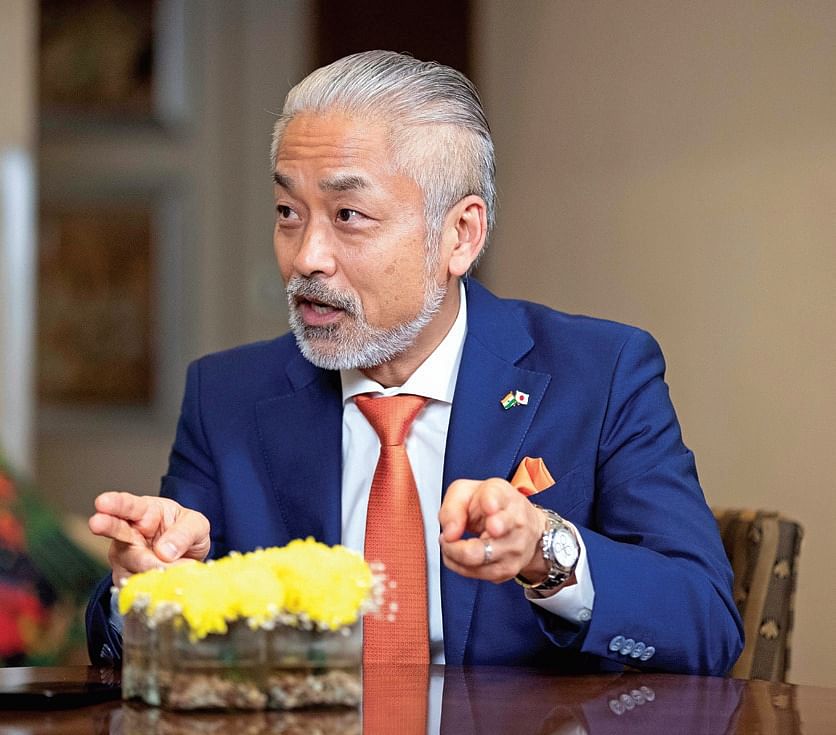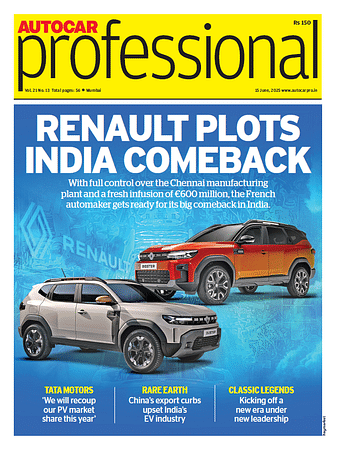'Demand has been far beyond our expectations' - Masakazu Yoshimura, Toyota Kirloskar
In an exclusive interview with Autocar Professional, Toyota Kirloskar CEO & MD Masakazu Yoshimura says the company is rapidly expanding capacity to meet India's growing demand for MPVs and SUVs, and to use the country as a base for exports.
With demand for Toyota Kirloskar's SUVs, cars and MUVs at an alltime high, the automaker is determined to expanding its production capacity and reduce the waiting time for its models, says Managing Director and CEO Masakazu Yoshimura. In the interview, he also talks about how Toyota’s global alliance with Suzuki is performing, the company’s journey towards net zero, and more.
Toyota had a phenomenal year in terms of volumes, revenues and profits. Could you recap 2024 and share the key drivers for success? What can we expect in 2025?
The year 2024 has been exciting and transformative for Toyota. Despite the challenges, we saw significant growth driven by our strong focus on customer satisfaction. Our goal is to create happiness through our products and mobility solutions.
Volumes, revenues and profits are just outcomes; the real drivers are our people—our teams, dealers, suppliers and everyone associated with the Toyota value chain. Their efforts ensure our products resonate with customers.
The response to our products—especially strong hybrids—exceeded expectations. The demand has been far beyond what we initially planned, and we’re grateful for the customers’ continued trust.
Looking ahead to 2025, we expect continued momentum driven by product innovation, enhanced production capacity and our focus on reliability and quality.
Toyota’s QDR—quality, durability and reliability—has been its backbone. Is this the key differentiator in an increasingly competitive market?
Absolutely. Quality, durability and reliability remain non-negotiable for Toyota. These principles are at the core of our identity. Competition in the market is fierce, but our philosophy is to remain just a little ahead—one step, even a millimetre—so customers choose our products with a smile.
A long waiting period has been a concern for customers. How have you addressed this challenge?
We deeply appreciate our customers’ love for the Toyota brand and sincerely apologise for the long wait times. The demand for our products, powerful hybrids, was far higher than we anticipated. Customers have been patient, and we thank them for their understanding. I often feel guilty about the delays. Cars, unlike quick meals, take time to build.
To address this, we are expanding capacity and increasing production at our Bidadi facility by 1 lakh units. A new plant in Aurangabad, Maharashtra, is also underway. These expansions will help us meet demand faster and reduce waiting periods.
How significant has the Toyota-Suzuki partnership been in this growth story?
The partnership with Suzuki has been mutually beneficial. Volumes from jointly designed products are split nearly 50:50, a healthy indicator. Both Toyota and Suzuki Japan are happy with the collaboration.
India-produced alliance models are also performing well. It’s not just on the hybrid side; the collaboration has extended to EV space, too. Globally, the alliance is progressing positively.
Toyota and Suzuki have complementary strengths. Suzuki excels in small car production, particularly in Kei cars in Japan. Its time-to-market and decision-making speed are remarkable. Toyota specialises in larger vehicles and hybrid technologies. We’ve also learned much from Suzuki’s local R&D centre in Rohtak, which operates efficiently and delivers faster results.
There have been concerns about Toyota rebadging Maruti Suzuki cars, given that Suzuki’s QDR standards are perceived differently from Toyota’s. Has this had any impact on the Toyota brand?
Suzuki’s QDR standards are very similar to those of Toyota. In some specific areas, their standards are even tougher and sometimes better. Suzuki’s local R&D facilities, such as their setup in Rohtak, allow them to test and simulate varied conditions like heat, dust and water more efficiently, using local materials. This enables quicker adaptation to the Indian market, which is a significant strength.
Toyota and Suzuki are committed to delivering quality products, and the partnership has allowed us to combine our expertise. Suzuki excels in small car production and agility in decision-making, while Toyota focuses on larger vehicles and hybrid technologies.
We are confident in the quality of Suzuki products, and the collaboration has been well-received in India and internationally.
What was Toyota’s initial reaction to launching rebadged Suzuki models? How did the market respond?
We were questioned when introducing the rebadged Suzuki models in India 5–6 years ago. Many were sceptical about whether customers would accept the partnership. However, the market response has exceeded expectations. Today, we receive numerous requests for quicker deliveries, which shows strong customer acceptance.
This success is due not only to the product itself but also to Toyota’s customer-centric approach. Our focus has always been on gaining customer satisfaction rather than just selling cars.
The global partnership has also performed well in international markets like Europe, where India-produced models are seeing tremendous success, particularly in the hybrid and EV segments. Toyota and Suzuki’s collaboration goes beyond simple rebadging. We work together to identify and address weak points in future product cycles.
For example, decisions regarding minor changes, such as cosmetics or colours, are relatively quick and straightforward. However, investments are required for major changes, like specifications or platform upgrades, and such decisions take more time. We maintain open and improved communication between our teams to ensure customer feedback is incorporated into the next facelift or product iteration.
 Yoshimura believes all technologies will coexist in India: ICE, strong hybrids, plug-in hybrids, EVs, ethanol, CNG and hydrogen.
Yoshimura believes all technologies will coexist in India: ICE, strong hybrids, plug-in hybrids, EVs, ethanol, CNG and hydrogen.
Toyota has emphasised strong hybrids over EVs. What is Toyota’s path to net zero, and how do you see EVs evolving?
The journey to net zero cannot rely on a single power train. Multiple fuel options—ICE, strong hybrids, plug-in hybrids, EVs, ethanol, CNG and hydrogen—will coexist. Customer preferences vary based on geography, infrastructure and use cases. Strong hybrids have been well-accepted worldwide.
For example, PHEVs are gaining popularity in China and are often sold as EVs. The market is evolving rapidly, and Toyota aims to offer diverse solutions. India, being the second-largest sugarcane producer, has an opportunity to process ethanol as a fuel, supporting the farming community while reducing emissions. We are also exploring ethanol-hybrid combinations similar to Brazil’s flex-fuel vehicles.
Will Toyota invest in diesel vehicles in the future?
Diesel demand remains strong in many regions. We will continue offering diesel vehicles as long as regulations permit. Modern diesel technology has evolved significantly—it’s no longer smoky or noisy. However, the transition to BS-VII emission norms will determine future viability. If regulations or costs become prohibitive, we will reassess.
What role will exports play in Toyota India’s growth?
Exports are critical for us, and this year, our export volumes grew by over 60%. While the base is small compared to competitors, India has strong potential as an export hub, particularly for the Middle East and GCC markets. We prioritise meeting domestic demand first, as waiting periods for models like the HyCross remain high. Increasing capacity will allow us to serve both domestic and export markets efficiently.
Is there a target for 2030 volumes? How do you see India’s role in Toyota’s global strategy?
While we don’t have a defined target, volumes by 2030 will be significantly larger than today. India is emerging as a highly competitive manufacturing base. Many global OEMs are setting up R&D centres here, positioning India as a future export hub. However, Toyota has factories worldwide, and increased exports from India can impact other regions. One path forward is focusing on India-specific products for domestic and export markets.
What are the top lessons you’ve learned in India after living in different countries?
India has taught me three key lessons—speed: the pace of change in India is unmatched; people first: listening, trusting and empowering people are essential; flexibility and agility: one must adapt quickly to shifting market dynamics. These principles are vital for success in a market as dynamic as India.
What is your approach to pricing and cost management in India?
We determine the retail price based on customer expectations and then reduce costs. It’s never a cost-plus model. We rely on methods like Kaizen and TPM (Total Predictive Maintenance) to improve efficiency and optimise costs while maintaining quality. India’s rapid growth in disposable income will continue to drive demand, and we must produce competitively for both domestic and export markets.
RELATED ARTICLES
India: A Bastion Of Stability for Schaeffler
German autoparts maker Schaeffler’s CEO, Klaus Rosenfeld, describes India’s role in the company’s €24-25 billion empire....
'No Question of Us Being Late' - Suzuki India on e-2Wheeler Market
Suzuki Motorcycle India believes its EV entry is timely as the market is now mature enough to grow off genuine demand ra...
'India Can Become a Major Pillar for Us' - Marquardt Group
Björn Twiehaus, CEO of Marquardt Group, and Vishal Narvekar, the company's India GM, share their outlook on the Indian m...





 By Ketan Thakkar & Hormazd Sorabjee
By Ketan Thakkar & Hormazd Sorabjee
 02 Jan 2025
02 Jan 2025
 24876 Views
24876 Views







 Angitha Suresh
Angitha Suresh

 Darshan Nakhwa
Darshan Nakhwa

